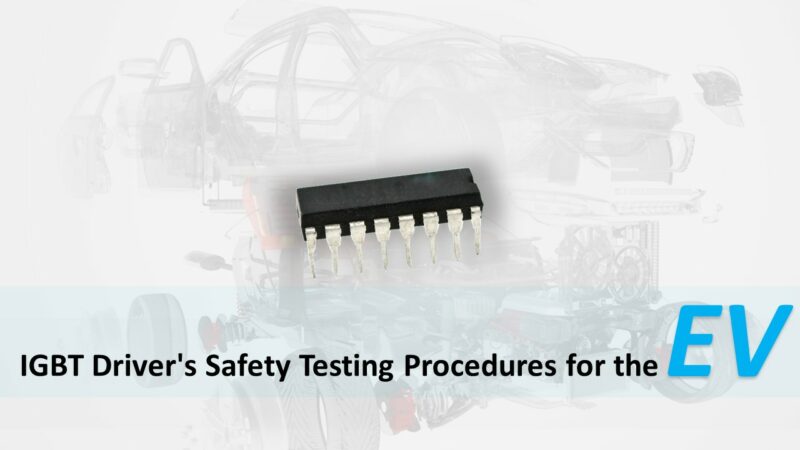Let us not doubt that the EV bandwagon is continuing due to its eco-friendliness, technological advancements, and government support for sustainable transportation. According to Goldman Sachs, global EV sales are expected to surge from 2 million units in 2020 to 73 million units in 2040. With such a promising future, there are current challenge to consider, such as the scarcity of Insulated-Gate Bipolar Transistors (IGBTs) because of their heavy usage in EVs and other high-powered industries. These tiny components are capable of rapid power switching for optimal performance, but they require suitable gate drivers to isolate high voltage, protect against short circuits, and maintain proper switching speed while minimizing damage risks. In this article, we will explore the electrical safety standards and testing procedures for IGBT gate drivers as we navigate this exciting and transformative era of EVs.
Understanding the Relevant Standard
To ensure the safety and reliability of IGBT gate drivers, the first step is to understand the relevant electrical safety standards, which are the IEC 60747 and UL 1577. Additionally, it is necessary to develop a comprehensive test plan that incorporates the required electrical safety tests, such as the Hipot test.
The Hipot test is a critical test that verifies whether an IGBT gate driver can withstand high-voltage loads, typically 1.2 kV and higher, by applying a testing voltage for 60 seconds between the input and output terminals. Manufacturers may increase the voltage to 120% of the isolation voltage (which is typically 1.44 kV or higher) during production to reduce testing time to 1-2 seconds.
Furthermore, the UL 1577 standard mandates the use of double-protection devices to conduct discharge tests, which consist of two tests. The first test involves applying a 20 kV DC voltage and discharging it for 5 seconds, repeating this process 50 times to check for visible signs of damage. The second test requires the greater of the isolation voltage or 3.5 kV for 60 seconds and is known as the Hipot test. By following these standards and testing procedures, IGBT gate drivers can be used safely in the growing field of EV technology.
Select Appropriate Testing Instrument
IGBTs and their gate drivers are commonly used in high voltage applications, making it crucial to use safe, accurate, and reliable testing equipment to ensure compliance with safety standards. Additionally, testing high voltage and double-protection gate drivers requires higher testing voltages than the standard Hipot testing voltage range of 1.2 kV to 5 kV, such as 7.2 kV or higher. Therefore, it is important to choose the appropriate testing instrument after understanding the standard requirements.
The HypotULTRA® Series Electrical Safety Tester is a premier line of Hipot Testers suitable for both laboratory and production line settings. It can provide up to 5kVac and 6kVdc Hipot testing voltage, significantly improving efficiency with its direct barcode scanner connection and user-friendly touch screen interface.
For testing voltages over 5kVac/6kVdc and double-protection gate drivers, the HypotMAX® Series High Voltage Hipot Tester is the recommended option. If your testing voltage is up to 10Vac, you can select the 7705 model. If your testing voltage is up to 12kVdc, then the 7710 model is your best option. For even higher testing voltage or UL 1577 double-protection gate driver discharging test, depending on the AC or DC voltage, you can choose either the 7715 (20kVac) or the 7720 (20kVdc) model. These models feature an intuitive user interface that offers confidence and control. Additionally, they can be automated with a PC to further enhance efficiency and productivity.
By using Associate Research Testers, you can take your production line to the next level and ensure that your IGBT gate drivers meet the highest quality standards for safety and reliability.
Providing Safer Workstation and Safety Training
To further enhancement, it is important to provide a safer workstation and ensure that operators have complete training. Setting up a safe and secure workstation with insulation mats, signal lights, and other PPE can significantly reduce the risk of accidents and injuries in the workplace. Providing comprehensive electrical safety testing training to operators can help them become more familiar with electrical safety theory and testing instrument usage, reducing the likelihood of serious hazards occurring during testing.
The rise of electric vehicles has increased the demand for Insulated-Gate Bipolar Transistors (IGBTs) and their gate drivers, making it essential to understand and adhere to relevant electrical safety standards and testing procedures. Using appropriate testing equipment, such as the HypotULTRA® Series Electrical Safety Tester and the HypotMAX® Series High Voltage Hipot Tester, can ensure compliance with safety standards while improving DUT’s quality. Moreover, providing a safer workstation and comprehensive electrical safety training can significantly reduce the risk of accidents and injuries in the workplace. As the world moves towards a greener future, ensuring the safety and reliability of IGBT gate drivers is critical for the continued success of EV technology and other high-powered industries.
References





